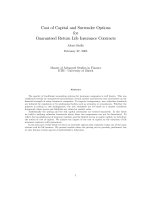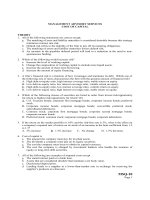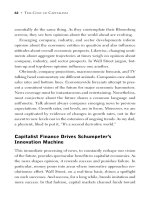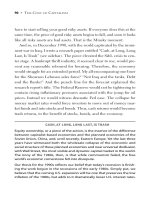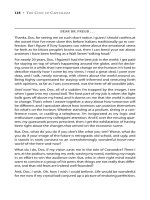Chapter 14 cost of capital
Bạn đang xem bản rút gọn của tài liệu. Xem và tải ngay bản đầy đủ của tài liệu tại đây (315.22 KB, 43 trang )
Chapter 14
Cost of Capital
McGraw-Hill/Irwin
Copyright © 2010 by The McGraw-Hill Companies, Inc. All rights reserved.
Key Concepts and Skills
•
Know how to determine a firm’s cost of equity
capital
•
Know how to determine a firm’s cost of debt
•
Know how to determine a firm’s overall cost of
capital
•
Understand pitfalls of overall cost of capital and
how to manage them
14-2
Chapter Outline
•
The Cost of Capital: Some Preliminaries
•
The Cost of Equity
•
The Costs of Debt and Preferred Stock
•
The Weighted Average Cost of Capital
•
Divisional and Project Costs of Capital
•
Flotation Costs and the Weighted Average
Cost of Capital
14-3
Why Cost of Capital Is
Important
•
We know that the return earned on assets
depends on the risk of those assets
•
The return to an investor is the same as
the cost to the company
•
Our cost of capital provides us with an
indication of how the market views the risk
of our assets
•
Knowing our cost of capital can also help
us determine our required return for
capital budgeting projects
14-4
Required Return
•
The required return is the same as the
appropriate discount rate and is based on
the risk of the cash flows
•
We need to know the required return for
an investment before we can compute the
NPV and make a decision about whether
or not to take the investment
•
We need to earn at least the required
return to compensate our investors for the
financing they have provided
14-5
Cost of Equity
•
The cost of equity is the return required by
equity investors given the risk of the cash
flows from the firm
–
Business risk
–
Financial risk
•
There are two major methods for
determining the cost of equity
–
Dividend growth model
–
SML, or CAPM
14-6
The Dividend Growth Model
Approach
•
Start with the dividend growth model formula and
rearrange to solve for R
E
g
P
D
R
gR
D
P
E
E
+=
−
=
0
1
1
0
14-7
Dividend Growth Model
Example
•
Suppose that your company is expected to
pay a dividend of $1.50 per share next year.
There has been a steady growth in
dividends of 5.1% per year and the market
expects that to continue. The current price is
$25. What is the cost of equity?
%1.11111.051.
25
50.1
==+=
E
R
14-8
Example: Estimating the
Dividend Growth Rate
•
One method for estimating the growth rate
is to use the historical average
–
Year Dividend Percent Change
–
2005 1.23 -
–
2006 1.30
–
2007 1.36
–
2008 1.43
–
2009 1.50
(1.30 – 1.23) / 1.23 = 5.7%
(1.36 – 1.30) / 1.30 = 4.6%
(1.43 – 1.36) / 1.36 = 5.1%
(1.50 – 1.43) / 1.43 = 4.9%
Average = (5.7 + 4.6 + 5.1 + 4.9) / 4 = 5.1%
14-9
Advantages and Disadvantages
of Dividend Growth Model
•
Advantage – easy to understand and use
•
Disadvantages
–
Only applicable to companies currently paying
dividends
–
Not applicable if dividends aren’t growing at a
reasonably constant rate
–
Extremely sensitive to the estimated growth rate
– an increase in g of 1% increases the cost of
equity by 1%
–
Does not explicitly consider risk
14-10
The SML Approach
•
Use the following information to compute
our cost of equity
–
Risk-free rate, R
f
–
Market risk premium, E(R
M
) – R
f
–
Systematic risk of asset, β
))((
fMEfE
RRERR −+=
β
14-11
Example - SML
•
Suppose your company has an equity beta
of .58, and the current risk-free rate is
6.1%. If the expected market risk premium
is 8.6%, what is your cost of equity capital?
–
R
E
= 6.1 + .58(8.6) = 11.1%
•
Since we came up with similar numbers
using both the dividend growth model and
the SML approach, we should feel good
about our estimate
14-12
Advantages and
Disadvantages of SML
•
Advantages
–
Explicitly adjusts for systematic risk
–
Applicable to all companies, as long as we can
estimate beta
•
Disadvantages
–
Have to estimate the expected market risk
premium, which does vary over time
–
Have to estimate beta, which also varies over
time
–
We are using the past to predict the future,
which is not always reliable
14-13
Example – Cost of Equity
•
Suppose our company has a beta of 1.5. The
market risk premium is expected to be 9%, and the
current risk-free rate is 6%. We have used analysts’
estimates to determine that the market believes our
dividends will grow at 6% per year and our last
dividend was $2. Our stock is currently selling for
$15.65. What is our cost of equity?
–
Using SML: R
E
= 6% + 1.5(9%) = 19.5%
–
Using DGM: R
E
= [2(1.06) / 15.65] + .06 =
19.55%
14-14
Cost of Debt
•
The cost of debt is the required return on our
company’s debt
•
We usually focus on the cost of long-term debt or
bonds
•
The required return is best estimated by computing
the yield-to-maturity on the existing debt
•
We may also use estimates of current rates based
on the bond rating we expect when we issue new
debt
•
The cost of debt is NOT the coupon rate
14-15
Example: Cost of Debt
•
Suppose we have a bond issue currently
outstanding that has 25 years left to
maturity. The coupon rate is 9%, and
coupons are paid semiannually. The bond
is currently selling for $908.72 per $1,000
bond. What is the cost of debt?
–
N = 50; PMT = 45; FV = 1000; PV = -908.72;
CPT I/Y = 5%; YTM = 5(2) = 10%
14-16
Cost of Preferred Stock
•
Reminders
–
Preferred stock generally pays a constant
dividend each period
–
Dividends are expected to be paid every
period forever
•
Preferred stock is a perpetuity, so we take
the perpetuity formula, rearrange and
solve for R
P
•
R
P
= D / P
0
14-17
Example: Cost of Preferred
Stock
•
Your company has preferred stock that has an
annual dividend of $3. If the current price is $25,
what is the cost of preferred stock?
•
R
P
= 3 / 25 = 12%
14-18
The Weighted Average Cost
of Capital
•
We can use the individual costs of capital
that we have computed to get our
“average” cost of capital for the firm.
•
This “average” is the required return on the
firm’s assets, based on the market’s
perception of the risk of those assets
•
The weights are determined by how much
of each type of financing is used
14-19
Capital Structure Weights
•
Notation
–
E = market value of equity = # of outstanding
shares times price per share
–
D = market value of debt = # of outstanding
bonds times bond price
–
V = market value of the firm = D + E
•
Weights
–
w
E
= E/V = percent financed with equity
–
w
D
= D/V = percent financed with debt
14-20
Example: Capital Structure
Weights
•
Suppose you have a market value of equity equal
to $500 million and a market value of debt equal to
$475 million.
–
What are the capital structure weights?
•
V = 500 million + 475 million = 975 million
•
w
E
= E/V = 500 / 975 = .5128 = 51.28%
•
w
D
= D/V = 475 / 975 = .4872 = 48.72%
14-21
Taxes and the WACC
•
We are concerned with after-tax cash flows, so
we also need to consider the effect of taxes on
the various costs of capital
•
Interest expense reduces our tax liability
–
This reduction in taxes reduces our cost of debt
–
After-tax cost of debt = R
D
(1-T
C
)
•
Dividends are not tax deductible, so there is no
tax impact on the cost of equity
•
WACC = w
E
R
E
+ w
D
R
D
(1-T
C
)
14-22
Extended Example – WACC - I
•
Equity Information
–
50 million shares
–
$80 per share
–
Beta = 1.15
–
Market risk
premium = 9%
–
Risk-free rate = 5%
•
Debt Information
–
$1 billion in
outstanding debt
(face value)
–
Current quote = 110
–
Coupon rate = 9%,
semiannual coupons
–
15 years to maturity
•
Tax rate = 40%
14-23
Extended Example – WACC - II
•
What is the cost of equity?
–
R
E
= 5 + 1.15(9) = 15.35%
•
What is the cost of debt?
–
N = 30; PV = -1,100; PMT = 45; FV = 1,000;
CPT I/Y = 3.9268
–
R
D
= 3.927(2) = 7.854%
•
What is the after-tax cost of debt?
–
R
D
(1-T
C
) = 7.854(1 4) = 4.712%
14-24
Extended Example – WACC - III
•
What are the capital structure weights?
–
E = 50 million (80) = 4 billion
–
D = 1 billion (1.10) = 1.1 billion
–
V = 4 + 1.1 = 5.1 billion
–
w
E
= E/V = 4 / 5.1 = .7843
–
w
D
= D/V = 1.1 / 5.1 = .2157
•
What is the WACC?
–
WACC = .7843(15.35%) + .2157(4.712%) =
13.06%
14-25
